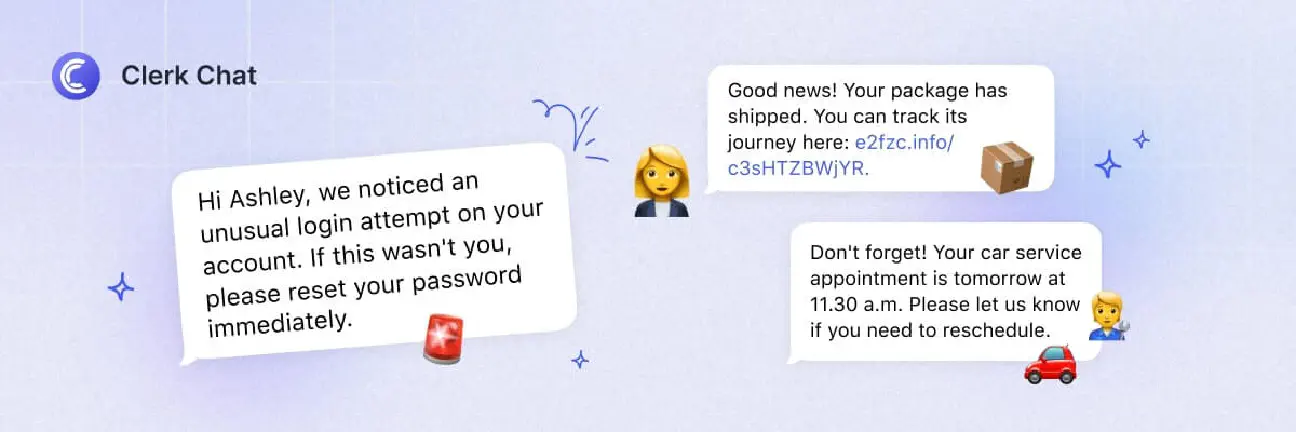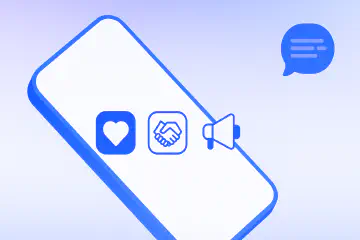Transactional Messages: The Ultimate Guide for Businesses
By Team Clerk Chat
- Published: August 30, 2024
Transactional messages are something most consumers are familiar with today. If you’ve ever gotten an instant alert on your phone, or via email after making a purchase, or received an SMS telling you your order is out for delivery, you’ve interacted with a transactional message.
For businesses, however, it’s easy to overlook how valuable transactional messaging really is. It’s not just another way to use your mass texting service to keep customers up to date or ensure they can access their accounts with two-factor authentication.
These messages, especially when leveraging conversational AI for ecommerce, actively improve customers’ experiences with your business and can help differentiate you from the competition.
So, what actually is a transaction message? What are the benefits of using them in your business communication plan, and how can you make sure you implement them correctly?
What are Transactional Messages?
A transactional message is a type of automated communication delivered to customers in real-time, usually via SMS, or email, based on an action they’ve taken.
For instance, an automated messaging solution might immediately notify a customer when they place an order, or request a password change. Unlike promotional messages, which are intended to encourage customers to purchase something or complete another action, transactional messages just give customers the information they need.
Their purpose is to improve the customer experience, keeping them up to date on orders with scheduled texts, reminding them of upcoming appointments, or allowing them to complete an action, like logging into an account with a one-time passcode.
The Common Types of Transaction Message
Transactional messages can include any type of message intended to convey crucial information to your customers, without encouraging them to make a purchase. For instance, if you use your Teams text messaging service to send a confirmation message to customers when they submit a form, make a payment, or reset a password, that’s a type of transactional message.
Other common examples include:
- Notification messages: Notes sent to inform customers of changes, such as important account activities (someone trying to enter their account), or changes to business policies.
- Delivery messages: Messages that provide information about a delivery, such as when it’s been sent out, where it is in transit, and whether there have been any delays.
- Reminder messages: Notifications that remind customers of upcoming appointments, events, deadlines, or upcoming payment requests (for subscriptions).
- Receipts: Digital receipts that outline the details of whatever a customer has purchased, how much it cost, and the payment method used.
Notably, transactional messages aren’t just sent via SMS. Although SMS messaging is one of the most common (and effective) ways to connect with modern audiences (as you can see from our list of transactional SMS examples), companies do use other channels too.
Companies might use push notifications to grab a customer’s attention on a mobile app or in a website browser. Emails can also be used to send transactional notifications.

The Compliance Standards for Transactional Messaging
As mentioned above, there are a few things that differentiate transactional messages from promotional messages. For instance, transaction messages aren’t used for SMS lead generation, and they rarely involve a lot of back-and-forth 2-way communication.
The biggest difference for businesses to be aware of, however, is that transactional notifications are subject to different rules in the world of email and text message compliance.
While it can still be helpful to acquire consent to send these messages to customers, you don’t necessarily need to get “explicit consent” to start a transactional campaign. As soon as someone agrees to allow your push notifications on their device, or gives you their contact details, they’re basically “opting-in” to receiving these messages.
This form of opt-in is usually enough to adhere to things like 10DLC registration requirements, TCPA guidelines, and other regulation standards.
The only time this changes, is when you add to your transactional content with more promotional content. For instance, if you add a new product suggestion to an order receipt, or launch a discussion with a customer using SMS conversational text marketing, you then need their explicit consent.
The Benefits of Transactional Messages for Businesses
As mentioned above, it’s easy to overlook the value of transactional notifications for businesses, because they’re not designed to directly increase your sales or promote your products.
However, these types of messages do have benefits. First, they boost your chances of keeping your customers engaged and connected with your brand – particularly if you’re using SMS. Text messages have an open rate of around 98% - much higher than email or social media messaging.
The more customers hear from your brand, the more familiar they’ll become with your company, meaning they’re more likely to think of you the next time they need something.
Additionally, an A2P SMS focusing on transactional content can be an excellent way to improve customer experiences. Although you probably won’t be able to offer the same in-depth level of customer service with this type of messaging as you would with 2-way messaging, you can still help, support, and educate your customers.
Transactional messages give you a quick and easy way to share vital information with customers and help them complete crucial tasks, like regaining access to their account when they lose their password.
Providing you follow the right SMS archiving regulations and compliance guidelines, you can even combine your transactional messages with other communication strategies, from SMS-based customer service to promotional messaging, giving you more ways to connect with your audience.
The right strategy can even help you to gather valuable data about your customers and the journey they take with your brand, so you can build more effective marketing campaigns.
Top Tips for Effective Transactional Messages
Investing in transactional messaging is an excellent way to improve your chances of building stronger relationships with customers and earning their loyalty. However, just like any messaging strategy, you need the right plan of action. Here are our top tips for success.
1. Know the Compliance Rules
As mentioned above, transactional messages aren’t subject to the same compliance guidelines as promotional messages. You don’t always need to obtain explicit consent to send these notifications, but you should still be aware of which rules you need to follow.
Use a TCPA compliance guide for insights into when and why you’ll need to obtain explicit consent from customers to send them different types of notifications. Make sure you’re aware of 10DLC compliance guidelines, so you can avoid having messages deleted by carrier spam filters.
Think about the other elements of compliant business communication that might affect your company, determining when and how often you can send notifications to customers.
Keep in mind, you may still need to keep records of the messages you send to help you overcome any potential legal issues or complaints. This is particularly true in certain industries, like finance, where financial messaging archiving is often essential.
2. Make Every Message Valuable and Useful
The whole point of sending transactional messages to customers is that you’ll be providing them with the information they need. The more valuable information you can include in the message, such as tracking numbers for orders or step-by-step instructions for password resets, the better.
While you might be limited in exactly how much information you can include, based on the short code texting service you’re using and regulatory guidelines, try to step into your customer’s shoes.
Think about what will make the journey easier for them, whether that means offering links to FAQs in your text, or providing extra contact details so they can get in touch with questions.
It makes sense to try and personalize these messages too, where possible. Integrating your messaging solution with your CRM system (through Hubspot SMS integrations) , ecommerce platforms, logistics tools, and other services will ensure you can deliver more relevant information to your customers.
3. Make Your Brand Stand Out
It often seems difficult to make your brand really stand out when you’re just sending basic transactional messages. You don’t have the same ability to build rapport and show off your personality as you would with conversational messaging.
However, a transaction message doesn’t have to be bland or boring. Messaging solutions like Clerk Chat allow you to create stunning and powerful templates you can use for all kinds of notifications. You can infuse your specific tone of voice and other brand elements into these templates, for a great chance of deeper connections with your audience.
Plus, using templates ensures your team members can consistently adhere to compliance standards when they’re sending each notification. This is crucial if you’re investing in group texting for business messaging, and you want to avoid any legal repercussions or fines.
4. Know When to Branch into Promotional SMS
Notably, transactional messages and promotional messages are two very different things. However, it is possible to sometimes combine both strategies. You could consider adding product recommendations to order receipts to encourage an additional sale, or offering customers a discount on their next purchase.
The important thing to remember here is that you can only add promotional elements to your campaign if you’ve obtained explicit consent from your customers. There are also some limitations on when you can send soliciting messages to customers, so it’s best to read up on “What is 10DLC”, and other guidelines to ensure you don’t end up in trouble.
Plus, it’s worth remembering some messaging services won’t be able to showcase all forms of content. For instance, if you want to include an image or link directing a customer to a new product in a receipt notification, those components won’t work if you’re texting a landline.
5. Choose the Right Technology
Finally, the best way to ensure you can make the most out of your transactional messaging strategy is with the right technology. A comprehensive messaging platform like Clerk Chat will give you all the tools you need to build a robust SMS and messaging strategy.
With Clerk Chat, you can build automated workflows, leverage state-of-the-art conversational AI for ecommerce to connect with your customers, and create highly personalized templates for each text message. Plus, the platform makes it easy to text people from different numbers, connect your technology stack with integrations, and maintain compliance.
With Clerk Chat, you can even monitor the results of your transactional messaging strategy, with in-depth insights and reports.
Unlock the Power of Transactional Messages
Transactional messages are more valuable than most companies realize. They give you the power to connect consistently with your audience, improve user experiences, and drive loyalty.
With Clerk Chat’s all-in-one platform, you can create all kinds of transactional and promotional messaging workflows that give your business an edge over the competition. Plus, you can ensure you’ll stay compliant with the latest industry standards.
Get started with a demo of Clerk Chat today!
In this article:
Ready to use your business number for text messaging?
Thousands of businesses are already experiencing the power of conversational messaging through SMS. Join us. Free trial and paid tiers available.
Get Started#Subscribe
Get product updates in your inbox
Tutorials, features, and Clerk Chat news delivered straight to you.




